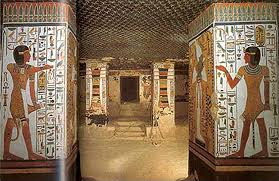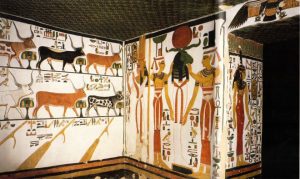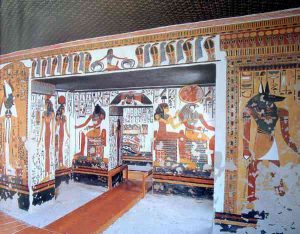
QV 66 The name 'Nefertari' (Meri-Mut) means 'The Most Beautiful of All', 'The Beloved of Mut'. Queen Nefertari married Ramses II before he ascended the throne and thus occupied a peculiar position in his life in general and in his court in particular: she was his friend, his confidant and the mother of his eldest son. Among her names were: "Hereditary Noblewoman; Great of Favors; Possessor of Charm, Sweetness and Love; Mistress of Upper and Lower Egypt; the Osiris; The King's Great Wife; Mistress of the Two Lands, Nefertari, Beloved of Mut, Revered Before Osiris". Her role, compared with the wives of other pharaohs, confirms her being part of the entourage of Ramses, not only during the civil and religious ceremonies, but even in major expeditions: she accompanied him in his expedition into Nubia in the 24th year of his reign (circa 1255 BC), on the occasion of the inauguration of the small temple of Abu Simbel (a temple dedicated to the goddess Hathor and Nefertari herself). She was one of the most important queens in the history of Ancient Egypt and one of the most beloved wives of Ramses II.
Other Queens were also venerated and worshipped, like Hetep-Heres (mother of Keops), Ahmose-Nefertari, mother of King Ahmose I, and Nefertiti (wife of Akhenaten). However, clearly observed from the Great Temple in Abu Simbel (which was dedicated to her husband) is the importance of Nefertari for Ramses II. The Queen's tomb was discovered by Ernesto Schiaparelli in 1904 and many specialists considered it the most beautiful burial all over Egypt. Due to the countless and serious problems affecting its wonderful paintings, the tomb was closed to the public in the 1950s, and until 1986, when its real restoration works began, preceded by multidisciplinary studies carried out by a group of international scientists. Primarily, the tomb was strengthened by plaster, then the fragments of its paintings (that had been detached from the walls) were restored to fix in their previous place, and finally, conservators proceeded to clean the old paintings and eliminate previous bad restorations. In April 1992, the restoration was completed, and by November 1995 the tomb was opened to the public, but with a much reduced quorum of visitors.
- The Antechamber of the Tomb of Queen Nefertari
 In the antechamber, we can observe the scenes of the solar disk rising between two red mountains in the eastern sky, accompanied by two falcons wearing the headdresses of Isis and Nephthys. Nekhbet (the Upper Egyptian vulture goddess), and Wadjet (the Lower Egyptian cobra goddess) are depicted protecting the entrance of the tomb. Scenes from the 17th chapter of the Book of the Dead show Nefertari playing a game of Senet, in which she must defeat an invisible opponent. If she gains, she will be able to access the Netherworld. Another scene depicts the ba-bird of the Queen standing above the tomb, with her body kneeling in adoration of the sun which is borne by two lions.
In the antechamber, we can observe the scenes of the solar disk rising between two red mountains in the eastern sky, accompanied by two falcons wearing the headdresses of Isis and Nephthys. Nekhbet (the Upper Egyptian vulture goddess), and Wadjet (the Lower Egyptian cobra goddess) are depicted protecting the entrance of the tomb. Scenes from the 17th chapter of the Book of the Dead show Nefertari playing a game of Senet, in which she must defeat an invisible opponent. If she gains, she will be able to access the Netherworld. Another scene depicts the ba-bird of the Queen standing above the tomb, with her body kneeling in adoration of the sun which is borne by two lions.
- The Vestibule of the Tomb of Queen Nefertari
In the Vestibule of the Tomb of Queen Nefertari, the most interesting scenes are: 1-Scenes of goddess Serqet standing on the left with a scorpion on her head and goddess Neith on the right, wearing her symbol, a shield and arrows. 2- Scenes showing Khepri's beetle-shaped head as a manifestation of the sun god. 3- Scenes depicting Ra-Hor-Akhty receiving the Queen. 4- As well as different scenes of the beautiful Queen, Nefertari.
- The Side Chamber of the Tomb of Queen Nefertari
In the side chamber of the Tomb of Queen Nefertari, there are plenty scenes worth seeing: there are scenes of figures of goddess Ma'at (goddess of justice and order), a scene depicting Nefertari standing before a table of offerings; scenes of chapter 94 of the Book of the Dead; scenes showing Nefertari offering a huge pile of food to Atum, scenes of the Queen in adoration before seven sacred cows and a bull; and others depicting Osiris and the Four Sons of Horus, including – among other drawings – live cattle, haunches of beef and vegetables.
- Inner Ramp and Staircase of the Tomb of Queen Nefertari

In the inner ramp and staircase of the Tomb of Queen Nefertari, one can see serpents wearing the crowns of either Upper or Lower Egypt on each side of the gate and other gods welcoming Queen Nefertari into the Netherworld, in front of tables of offerings.
- The Burial Chamber of the Tomb of Queen Nefertari
The Burial Chamber of the Tomb of Queen Nefertari is decorated with scenes of different chapters of the Book of the Dead in which Queen Nefertari had to face three genii and other different threats in order to cross the gates to the Iaru (the Paradise Fields). Scenes of the queen depicted on the tomb's pillars are considered of the best paintings preserved from Ancient Egypt.
